7 Symptoms of a Clogged or Bad Radiator (and Replacement Cost)
When your radiator is clogged, not working as efficiently as intended, or has simply gone bad, not enough cooling is taking place inside the engine. This can result in your car overheating and if not fixed soon enough, permanent damage to the internals of your engine.
A radiator can be clogged from the inside, outside, or simply fail altogether. Here are some signs of a clogged radiator you’ll want to look for before overheating and expensive engine damage takes place.
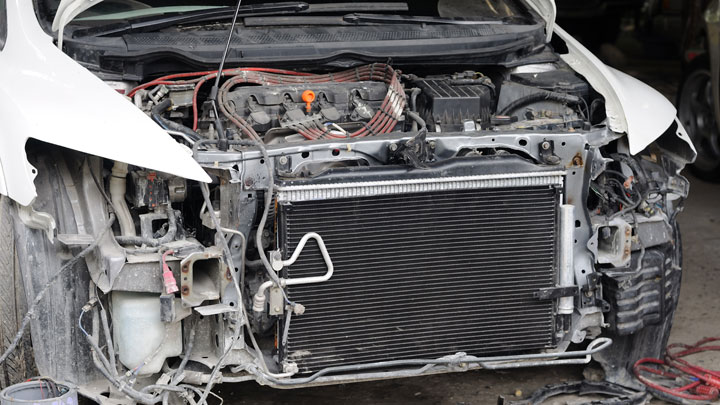
Related: 3 Reasons for a Collapsed Radiator Hose
Common Symptoms of a Bad or Clogged Radiator
#1 – High Temperature Gauge Readings
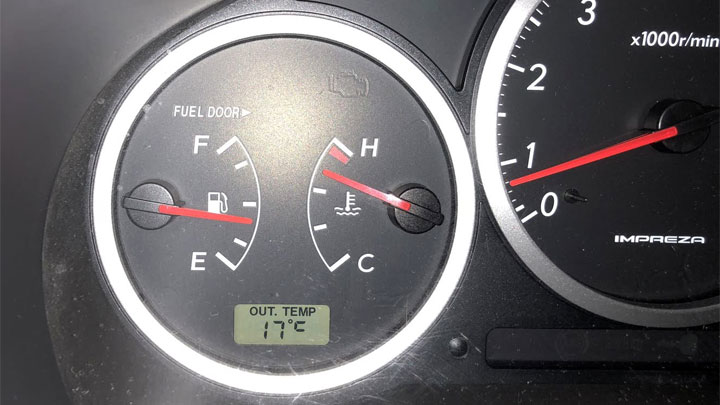
Since a functional radiator prevents the engine from overheating, you will know something is wrong with the radiator if the engine starts overheating.
Monitor the temperature gauge to see if the readings are higher than usual or if the needle is in the “red” zone. Some newer cars will display the temperature digitally and warn you when the engine temperature gets too high.
A normal operating temperature for most cars is somewhere between 195 and 220 degrees F. If the temperature falls slightly out of that range, it’s often not a cause for alarm, especially in summer months when the air conditioner is constantly running.
But if the temperature consistently stays on the hot side, it’s possible you have a clogged radiator. This usually occurs from corrosion due to rust, internal deposit buildup over time, or debris getting stuck in the radiator which prevent the proper amount of coolant from circulating through the radiator and your engine.
#2 – Coolant Leaks
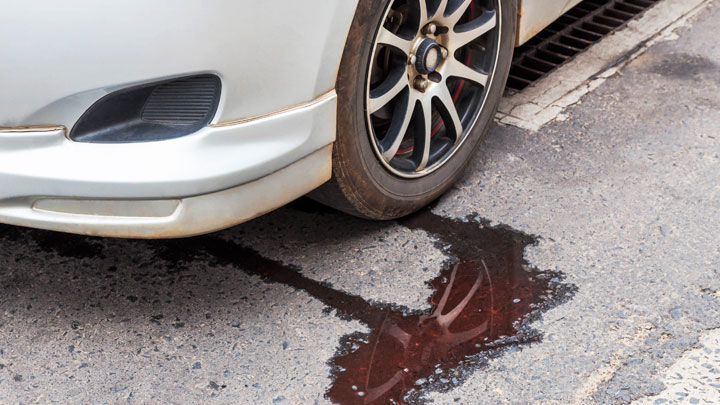
The housing or cooling fins may develop tiny holes or cracks on them when the radiator is clogged due to severe rust buildup. Once this happens, you may be able to see small drops of coolant on your garage floor or driveway.
The rust inside your radiator often forms due to a low quality coolant or adding regular tap water (instead of distilled) to the coolant mix which has many more contaminants. If a radiator flush is not regularly done, more and more rust will form and start eating away at the radiator tank.
With even the slightest coolant leak, your vehicle will be forced to operate with an insufficient amount of coolant and the low coolant level light may illuminate in your dash.
If you don’t fix the leak as soon as possible (or at the very least keep the coolant level topped off), your engine may overheat and even need expensive repairs due to internal damage.
#3 – Fluid Discoloration
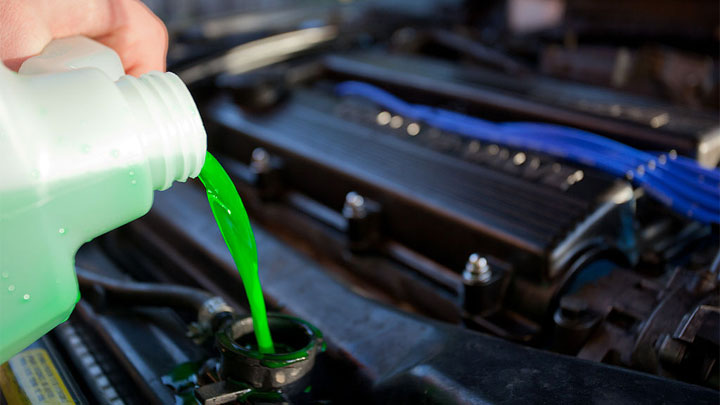
Vehicle coolant should be a bright color, often green, yellow, or orange (but sometimes red, pink, or blue) and flow freely through the radiator and coolant passages within the engine.
Over time, internal deposits and even sludge can contaminate the coolant. This will turn it into more of a rusty color or even the color of oil. Checking the coolant overflow tank is often the easiest way of checking the condition of the coolant.
This contaminated fluid will also be slightly thicker and not allow it to easily flow through the cooling system. This in turn starts to clog up the radiator and if you let it get bad enough, the radiator’s efficiency may reduced to the point of causing your car to overheat. A radiator flush should be performed asap.
In addition, some vehicles have a transmission cooler located within the radiator. If a leak occurs in the barrier that separates the two, the coolant and transmission fluid would mix and cause double the trouble.
#4 – Exterior Radiator Fins Blocked
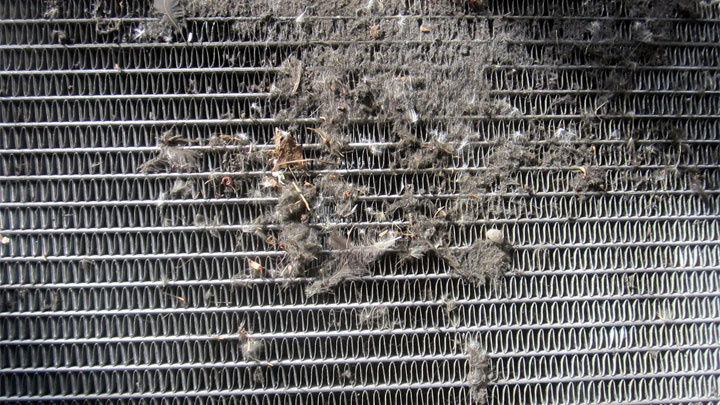
Radiators are designed for maximum cooling. To accomplish that, thin fin tubes run across the front of the radiator. These tubes carry hot coolant. As you drive, the radiator fan pushes outside air on and around these fins to lower the temperature of the coolant before it flows back into the engine.
If these tubes become clogged up by dirt, bugs, leaves, or other material, the airflow is blocked which doesn’t allow the coolant to cool as much as it needs to.
On most cars, there is usually enough access (you may need to remove a plastic cover or two) to use a garden hose and spray nozzle to wash off any debris that may be blocking the front of the radiator.
#5 – Bent or Damaged Fins on the Radiator
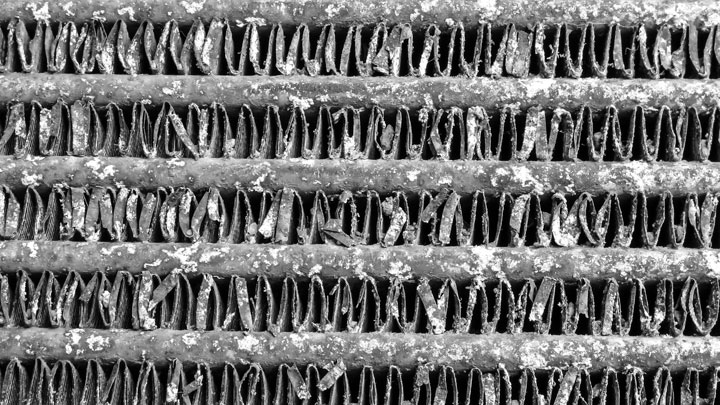
In addition to clogging due to foreign material stuck to the front of the radiator, airflow can also be blocked when enough fins get bent or damaged. These fins are extremely delicate and a piece of tiny gravel hitting them while driving can cause damage.
Damage can also occur during installation of a new radiator or even when spraying water to clean off the fins.
If too much water pressure is used such as when using a concentrated stream or pressure washer, the fins can easily bend and block the flow of air. When enough fins are damaged, it can clog the radiator enough to cause engine overheating.
#6 – Heater for Passenger Area Not Working
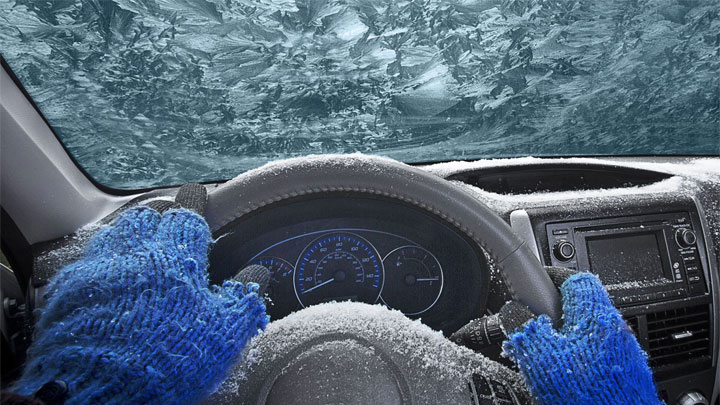
The cabin heater of a car depends on hot coolant passing through the heater core and then the resulting hot air being blown into the passenger area by a blower fan. If the radiator is clogged or has a leak, not enough hot coolant makes its way to the heater core to allow proper warming of the car’s interior.
A bad thermostat is most often the issue but sometimes, an issue with the radiator can be the culprit.
#7 – Cold Lower Radiator Hose
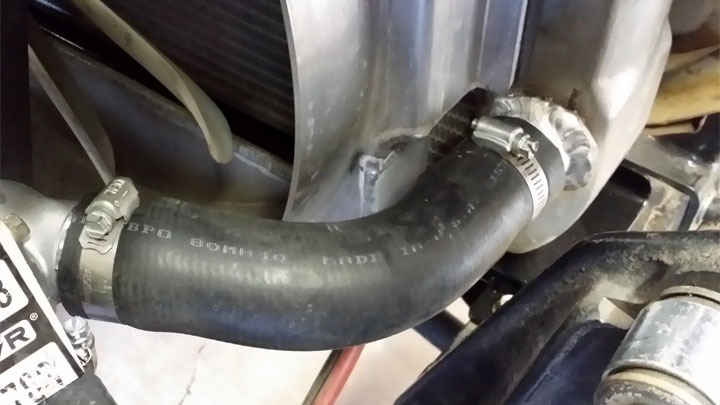
If your radiator is doing its job, you will notice that the top radiator hose can be very hot to the touch but the lower hose is merely warm as the coolant travels through the radiator.
But after driving around a bit you notice that the lower radiator hose is cold, there’s a chance your radiator has a blockage preventing the full flow amount from going back to your water pump.
Average Radiator Replacement Cost
Best places to order parts? See: 19 Best Online Auto Parts Stores
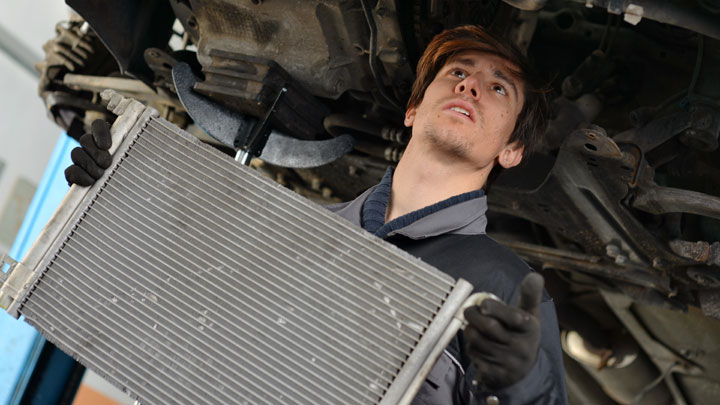
The cost to replace a radiator is one of those things that can vary quite a bit. Overall, you can expect to pay somewhere along the lines of $200 to $900 total to replace a radiator with most vehicles falling in the $400-$500 range.
A typical radiator with aluminum core and plastic tanks can run anywhere from $100 to $600 depending on vehicle make and model and whether it’s OEM or aftermarket.
Something like a Ford Focus radiator is going to be on the lower end while something like a Chevy truck with a large Duramax engine (with built in oil cooler) or luxury car will be on the upper end.
The amount of time it takes to replace a radiator also varies. For some cars with easy access, it can be a 1-hour job while some tighter, more complicated set ups (ie: Audi or Porsche) can take closer to 3 hours. Expect to pay somewhere in the vicinity of $100 to $300 for labor.
In addition, other parts may also be necessary as part of the job. New coolant is usually needed and sometimes hoses, hose clamps, radiator cap, and the thermostat are also replaced at the same time. Factor in an additional $15 to $100 in miscellaneous parts.
- Replace the Engine or Replace the Car? (11 Factors to Consider) - Apr 11, 2024
- Plastic Piece Dragging Under Your Car? (What It Is and What To Do) - Mar 21, 2024
- Timing Belt vs Timing Chain (What’s the Difference?) - Feb 27, 2024

I have a 2012 Chevrolet Impala LS fleet. We changed the water pump recently. About a year and half ago we had replaced the radiator. Now we noticed that there is sludge in the overflow tank and we have trouble sometimes going into reverse. We flushed the radiator with radiator flush and did a long flush (3-6hour flush). We replaced with new coolant. Noticed that there is still some brown color in overflow tank. Is my radiator bad? Is it causing more problems with transmission? What van I do to fix the issues? Low income budget, so it’s going to be a DIY project
Overflow tanks often turn brown over time. I don’t think that alone is necessarily cause for concern.
Radiators often have a separate section for transmission cooling. You’ll see two transmission lines that hook up to the back of the radiator on the bottom, and those are used to cool the automatic transmission.
You could try cleaning out that portion of the radiator, or try replacing the radiator if you think your radiator is having issues.
I replaced the radiator in my car. Got in it turned on the air to make sure it doesn’t run hot again. But while driving it it, it was stalling so pulled over. It was steaming and it would not crank up. Let it cool and come back still will not crank. So mechanic says it’s blown head gasket. Could it be something else?
It’s probably a blown head gasket. Engines don’t like to be overheated repeatedly. It is very likely to damage something expensive. It could be something else, but it’s probably something else that’s also expensive.
You could ask him to do a leak down test to see if you can confirm that it’s a blown head gasket.
My Nissan qashqui is pushing coolant out the coolant bottle and the heat is cold now a days there seems to be pressure on it I’m just wondering if it’s the head gasket or if the radiator is clogged it doesn’t overheat unless I drive it on
Have you checked your radiator cap?
I have 1999 Ford Ranger 3.0. I am having to replace my radiator every 6 months. I also noticed the liquid in the resivor tank (i know i did not spell that right) never goes down at all, same liquid from a year ago, does that supposed to move around?
I replaced the radiator twice before with same pin hole leak, almost same area. 7 months later after new radiator and rack and pinion installed, I am having leaking issues, need to keep it topped off almost everyday.
Help.
Where is the radiator leaking from?
A reservoir is a container that allows coolant to enter and exit the radiator as needed. The level should stay roughly the same over time. If the coolant level drops, you have a leak somewhere. If the coolant level increases, it’s due to overflow from the radiator. This is normal and happens when the system is under pressure. You’ll notice the coolant in the reservoir drop back down to its original level when the engine cools down.
I have a2004 chevy silverado with a 6.0 and i changed water pump and thermostat and vehicle overheats fast while in idle and it start blowing all of my coolant out the resevoir what could that be
How long does it take for the truck to overheat? Have you verified that the thermostat installed correctly? It’s possible the cooling system may be blocked somewhere.
I have a Toyota Corolla 2009, the temperature begins to rise when the car air-conditioning is switched on!!!
Without the air-condition on, the car runs normal …
Have you verified that both radiator fans are working properly?
I have a 2008 Saturn Aura XE 3.5 replaced the radiator, 2 weeks later it started to overheat so I replace the thermostat and that wasn’t the problem so I flushed the heater core since it doesn’t have heat either, the heater core looked just fine (no debris). I went a little cheap on the radiator so though maybe it was the hoses I replaced them today and nothing still overheating and also did a coolant flush and have the same issue. Think I need a new radiator what you guys think?
If it’s still overheating after replacing the radiator and thermostat, you could try replacing the radiator cap. If that doesn’t help, I would do a leak down test to see if it has a head gasket leak. A persistent overheating problem can often be the sign of a head gasket leak, but you’ll want to catch the issue sooner rather than later if you can since it can be pretty bad for the engine.
I have a 2011 chevy malibu car runs normal slightly cold, then will randomly go straight to cold. My ac will stop working but my heat will still run strong. Any idea what this could be? I’ve replaced the thermostat and ect sensor recently aswell.
I have a Honda City 1.5ltr 2011. Yesterday it started to heat up according to the digital sign on the tableau. During driving, the car suddenly couldn’t take any more power and started to reduce the speed down. I stopped on the side. No strange noise, just probably overheating. The engine, afterwards is running during ignition on but refuses to start. What might the problem be, please help me? A friend told me that I might need anothr engine replaced!
You really don’t want to run your car while your engine is overheating like that, as it could very easily ruin the engine.
First, you should probably figure out why the engine is overheating. There could be several components in the cooling system that have failed causing an overheat condition, including the thermostat and water pump. If a head gasket is leaking, you are also likely to overheat.
Check out this article for more information. I recommend bringing the car into a shop for further diagnosis if this is outside of your comfort zone.
http://cartreatments.com/causes-and-symptoms-of-engine-overheat/
My BMW 328i 2011 was at the dealership for scheduled service And they said it needed a new water pump, and recommended a new thermostat . They did the work and were refilling the coolant – and blew the radiator completely in half ! Hot coolant sprayed all over the work bay. Now I have to buy a new radiator and upper and lower hoses. What went wrong ? The bill is going to be $2,800.00 at least. Thank you for your advice.
That’s very strange. I would think they should cover the radiator and any other components that disintegrated due to their mistake. Maybe the radiator was already compromised in some way? Not really sure.
$2,800 seems very expensive to me, but I am not familiar with German cars (especially at dealership rates).
My husbands truck has a new engine but the radiator keeps needing to be replaced. The one he is replacing now is bowed and deformed. Friend said it was clogged bit when he took it out water ran freely through it. What is causing this problem?
The only things I can think of that would warp a radiator like that are heat, improper install, or if the mounts have shifted after an accident. If it’s a heat issue I would expect the vehicle to also be overheating. Verify you’re installing the correct radiator for the truck, then get in touch with the radiator manufacturer to see if they can determine it was a defect.
Late reply – I have had some similar situations. Unfortunately, the radiators today are junk.
The one for my vehicle ( a Astro van) is partially plastic – yes plastic.
I checked the dimensions and ordered an all aluminum race radiator.
The car dealerships today are only hoping you get down the road and that’s all.
By the way, I work on cars all the time and that radiator I was talking about, I replaced 7 times – yes I said that correctly, 7 TIMES in 9 years.
Yes, those plastic radiators will get brittle over time. Some will turn brown to let you know it’s probably about time to change them.
There is radiator fluid at the top of the radiator but the fluid from the reservoir seems to still be flowing and the gauge is at 50% most of the time. Does that mean the radiator needs to be replaced or can a radiator leak sealant be used?
If you’re referring to the temperature gauge staying at 50%, that’s generally where the needle sits when your vehicle is at normal operating temperature. This has no correlation to the radiator fluid level.
If your radiator overflow reservoir is non pressurized and it happens to be leaking, you can probably get away with simply replacing the reservoir without replacing the radiator.
I have a 2005 Kia Sedona I replaced the alternator and thermostat and its running hot and no leaks or anything what could it be
There are many reason why a car might overheat, so further diagnosis is needed. I recommend you take the car to a mechanic you trust in your area.
I have a 2006 Scion TC. For some reason the antifreeze comes out of the top air release hole and sprays all over the engine. Why might this be coming out of that particular hole?
Thanks!
That air release hole is designed to remove air from the system after you replace the coolant or open the cooling system. It sounds like the valve may be loose or have a bad o-ring. It should be an easy DIY fix. Make sure you don’t drive on low coolant, lest you risk overheating the engine.
I have 2013 hyundai i20… my engine temperature go high after run 80 to 100 kms done. The coolent comes out from reserviour tank.. after that whrn cools the engine and add some coolent . It again runs smooth for 80 to 100 kms.. Engine oil is clear no sludge. And no sludge in coolent.
Please do suggest what is the problem.
Air in the cooling system is a common culprit for overheating issues. Check to make sure there is no air in the system. Check the coolant level, both in the overflow tank and the radiator itself.
It is VERY important that you wait until the engine has completely cooled before removing the radiator cap, or you may burn yourself very badly! Also, make sure there are no leaks on the ground after driving. Some leaks may only manifest while the system is under pressure. A radiator pressure test rented from a local auto parts store may reveal these leaks as well.
Hi, I got 05 Scion TC and the coolant disappeared, kept on putting coolant in it, dont see any leak, I even layed a cardboard underneath, over night, and no leak, driver and passenger floor are dry, temperature gauge goes a little beyond normal and no heat, please help me find the main problem..thanks guys
hi did you find out the problem my car is doing the same thing its hard because I’m elderly and don’t have the money to fix it
I have a 1999 toyota Camry that’s running hot, addition too, fan aint coming on. In fact, i replace temperature sensor and cooling fan sensor, the fan want come on and its still running hot. I need to know should i get a new radiator or flush it …dont know need help?
It’s getting hot because fan not turning on.
Check the fan relay, it is located in the fuse box (either under dash or in engine bay), if thats the case then you’re looking at probably 15-20$ part amd do it yourself
2008 Pontiac Torrent 3.4L. Heater core was leaking so we replaced that but now inconsistent heat inside car. When driving the temp of engine goes to normal operating temp but air coming out of vents is hot but at idol it cools off immediately. We’ve disconnected heater core and flushed several times, replaced thermostat, and flushed everything we can think of….. we’ve even elevated front of car with a lift and checked for air in the system. Still having same issues- Any ideas?
I have a 2012 Jeep Grand Cherokee Laredo. Been overheating for a few months. We’ve replaced the water pump and thermostat (3 times) and also used Blue Devil twice thinking it was a blown head gasket. When it overheats we “burp” it and add more water to the radiator. The thing is, the water in the radiator is cold! There are no visible leaks anywhere. Can’t afford to take it to a mechanic right now either. Any help/ideas would be GREATLY appreciated.
Sounds like some sort of blockage in the radiator or lower hose collapsing if you’ve already replaced the thermostat and water pump. Other things to consider: was the thermostat put in backwards? was the serpentine belt put on the wrong side of the water pump pulley?
Hi my ford Everest 2013 model i’ve flushed the radiator several times and after two or three weeks theres oil inside the expantion tank and the engine will start to overheat and the engine oil is still ok without any water in it,my ver worrying concern is why is there oil in the water,please help..
Unfortunately, you likely have a blown head gasket (not a cheap fix). A local mechanic would easily be able to confirm.
Block test kit blue turns Green gaskets gone
I have a 06 grand prix, replaced thermostat, water pump and tensioner elbows. Radiator replaced less than a year ago. Car still overheats, only thing thats unusual radiator cap is hard to get of even when engine is cold.
My car is running hot and I have replace the thermostat and water pump but my engine is reving super high as it is crunk what could it be
I have a Lincoln navigator that has a radiator that is filled with dirt and oil caked on the whole outside and in the fins. What could be the reason?
The outside of the radiator can get dirty just from normal driving (bugs, dirt, etc.) or if you have an oil leak somewhere. It’s recommended to clean the radiator about once a year (or when the fins start clogging. After it’s allowed to cool, spray on some Simple Green or other degreaser on the front of the radiator and let it sit for a few minutes. Then, use low pressure water on the BACKSIDE of the radiator to rinse it off. The fins on the front are super delicate and prone to bending so never scrub the front (unless very gently with soft bristles) or spray water on the front.
Thanks
Very educative. In cars that do not have a temperature meter except for a glowing red light how does one monitor the terperature status. I have a Honda City 2011 model.
Thanks Joaquim. Since it doesn’t have a temp gauge, the easiest way would be to hook up a diagnostic scan tool that displays real-time data including the engine coolant temperature.
I’m a big fan of the BlueDriver but there are many other scanners that will read the temperature.
I have a 2004 dodge Durango 4.7 I changed thermostat and water pump and aux water pump my heads are not cracked checked them new raidtor cap my truck is still running hot the top hose is hot the bottom hose to thermostat is cool what is causing my thermostat not to open and flow all answers are very helpful
I have a 1999 Mitsubishi Galant it has been getting hot. I filled the overflow reservoir a week and a half ago and yesterday it got hot again when the ac was on. I turned the ac off and it went back to normal. When I got home and the car cooled down I looked and the reservoir was half empty. After I drove to work which was about a 30min drive I noticed the car smelled like coolant and a little when I went back outside there was a puddle under my car. Im not sure what to check any advice?
Common points of leaks are the radiator cap, reservoir tank, and the upper and lower radiator hoses so you want to check those first. But there are of course other areas (radiator, heater core, thermostat housing). A pressure test can also be done by a mechanic to find the leak.
Have a 2001 Nissan pathfinder. Its get hot when I drive a long distance about 25 miles. But around town its stay normal. Replace the Fan Clucth(that’s what a repair shop told was the Issue) the shop told that wasn’t the problem! Now their telling me I have a Clogged Radiator! 467$ to replace the Radiator! I’m going to flush the Radiator. What could the problem be? Need help Plz!
Had same problem definitely water pump. If you keep running it there will be more pressure in your water bottle and take cap off while driving
VERY HELPFUL INFORMATION! Definitely evidence of a small leak, however it is not leaking to the ground! A temperature gauge only ran hot once but my car does not blow heat consistently in the winter time does not blow cold air consistently in the summer! I have a mechanic check it he put coolant in the car and the air is working fine! There is still concern that there is a leak somewhere, but they want to charge me over $1000 to replace the radiator,
What kind of car has a $1000 radiator job? Maybe $150 for radiator and $150 to fit it. At the most you could double it. But that would be very generous.
try out bars stop leak head gasket sealer…follow instructions…do remember to flush out the old coolant and add new….instructions are easy ,also has addives that run coolant temperature down as the molecules inside it increases the heat transfer rate
My car is not running hot is no leaks we just replace the radiator but when I take the cap off I noticed the antifreeze is not circulating in the radiator and I am concerned about that but like I said there’s no leaks it’s not overheating it’s not running hot so what is the problem
Bad thermostat or water pump are the two common causes of coolant not circulating in the radiator although the car would overheat after a while. How long did you allow it to run?
I have a 05 Scion tC the heat has ran great! There has been no problem with it till yesterday. Started the car like normal and let it run for a couple minutes and took off driving. I turned the heat on and it wasn’t hot like it normally would be. Normally it’s hot within just a few minutes after starting it. But anyways the temperature read on cold and stayed there til I turned the heat off, it raised a little bit but it never got to the normal temperature. I stopped at a red light and the temperature gauge went up a little But like I said it never hit its normal mark. But my heat works fine, I just don’t understand. The coolant is good. Is my thermostat stuck open? My car has never ran hot!!
Someone has please help a girl out!!!!!
Sounds like the thermostat to me
your thermostat might be stuck open. take off the inlet housing remove the thermostat and replace the housing without the thermostat. fill with water to see if it circulates without it in. if not maybe water pump. However unless you’re going to fix it yourself it’s better to take it to a mechanic I found myself working on mine and it became much more complicated than I thought originally still dealing with it.
I have a 2006 Chrysler 300 and I changed the water pump and it still not flowing there is no water going thru heater core hoses when it’s running
Hi I replaced the thermostat and water pump and it still over heats Could the radiator be bad
Could be, but I would do a leak down test to see if you are getting combustion gases in the cooling system. That could be a sign of a bad head gasket. You could also try a combustion leak detection kit if you want to a slightly cheaper and easier route.